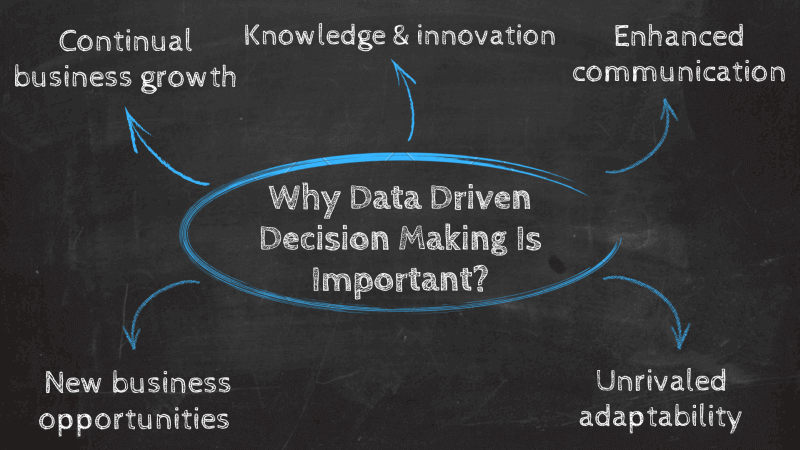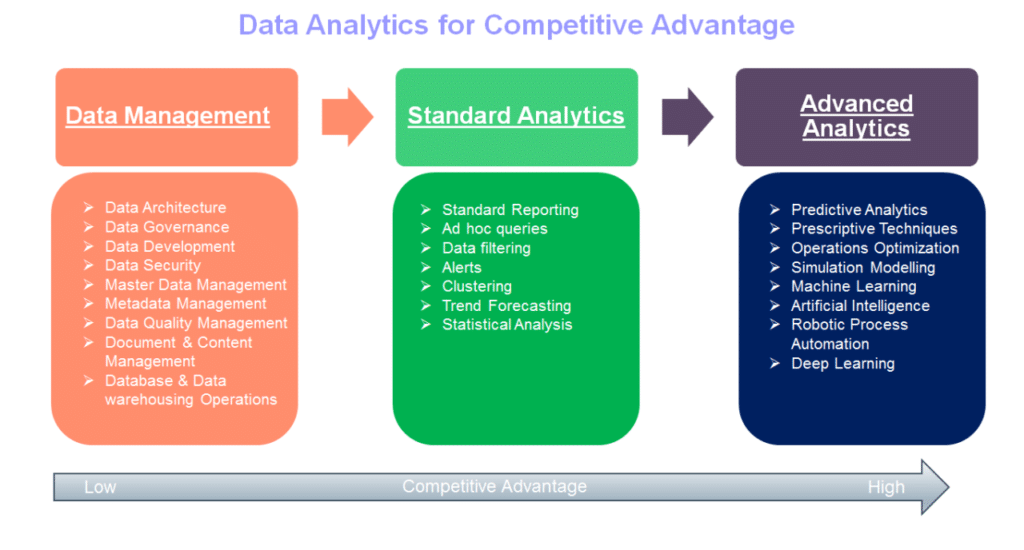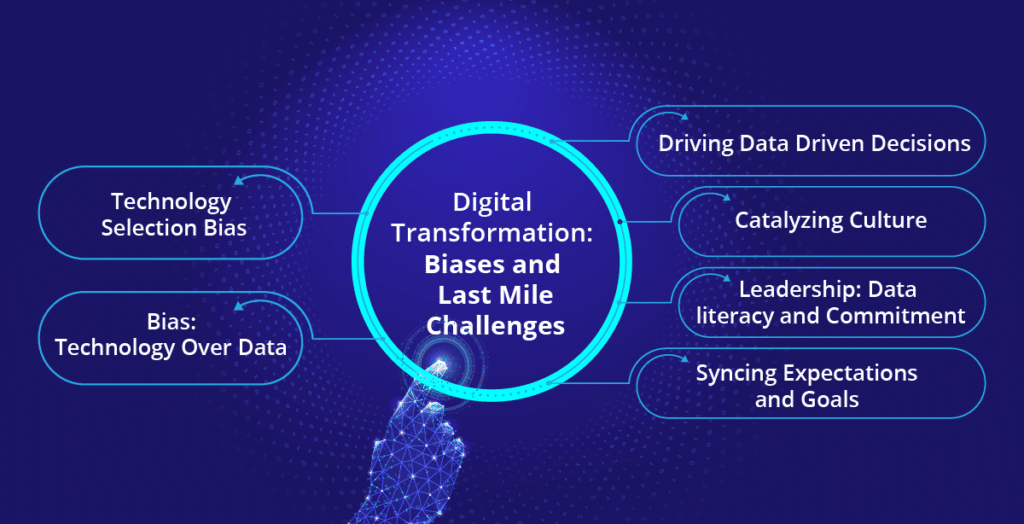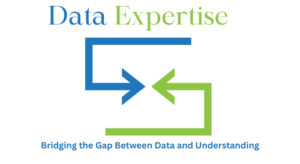Introduction
In the digital age, leveraging analytics for data-driven decision-making (DDD) is not just an advantage but a necessity for organizations aiming to stay competitive. This blog explores the transformative journey of embedding analytics into the fabric of organizational decision-making, ensuring that every choice is informed by data.
Understanding the Power of Data-Driven Decision-Making
Data-driven decision-making harnesses the potential of data analytics to inform and guide strategic decisions. By integrating analytics, organizations can uncover insights that lead to improved efficiency, innovation, and customer satisfaction. This section will delve into the benefits and challenges of adopting a data-driven approach.

1. Setting the Stage: Establish Clear Analytics Objectives Identify what your organization seeks to achieve through analytics. Goals can range from enhancing customer experiences to streamlining operations or boosting profitability. Setting clear, measurable objectives is crucial for directing your analytics efforts effectively.
2. Evaluating Your Data Ecosystem Assess your current data management capabilities, including data collection, storage, and analysis processes. Understanding the strengths and weaknesses of your existing data infrastructure is key to identifying necessary improvements or investments.
3. Crafting a Comprehensive Data Strategy Develop a strategic plan that encompasses data governance, quality control, and analytics methodologies. This strategy should align with your overall business objectives and include provisions for data security and privacy compliance.
4. Choosing the Right Tools and Technologies Explore analytics tools and platforms that fit your specific needs. Considerations include scalability, user interface, integration capabilities, and support for advanced analytics features like predictive modeling and machine learning.
5. Cultivating Analytical Talent Building or enhancing your team’s analytical skills is essential. Whether through training, hiring, or partnerships, ensure you have the expertise to interpret data and translate insights into action.
6. Promoting a Culture of Data Literacy Encourage an organizational culture that values data-driven insights over intuition. Leadership should champion the use of data in decision-making processes, demonstrating its impact through success stories and active engagement.
7. Starting Small: Pilot Projects Implement analytics initiatives with pilot projects that can provide quick wins and valuable learning experiences. These projects serve as proof of concept, demonstrating the value of analytics in achieving business objectives.
8. Expanding Analytics Across the Enterprise Based on the successes of pilot projects, gradually scale and integrate analytics practices across all facets of the organization. This section will offer guidance on making analytics a standard part of business operations and decision-making.
How Data-Driven Decision-Making Works
Data-driven decision-making (DDD) is the process of collecting, analyzing, and interpreting data to guide strategic and operational decisions. Instead of relying on instinct or experience alone, organizations use quantifiable insights to make more accurate, objective, and predictive choices.
The DDD process typically involves the following key stages:
- Data Collection – Gathering data from diverse sources such as customer transactions, web analytics, IoT devices, CRM systems, and external market data.
- Data Cleaning and Integration – Ensuring data accuracy, consistency, and completeness by removing duplicates, correcting errors, and integrating siloed datasets into a centralized data warehouse or lake.
- Data Analysis and Modeling – Using statistical techniques, visualization tools, and machine learning algorithms to extract patterns, trends, and correlations.
- Insight Generation – Translating analytical findings into meaningful insights that support decision-making. This step involves interpreting data in the context of business goals and challenges.
- Decision Implementation – Acting on insights to optimize processes, products, or strategies. For example, adjusting pricing, improving marketing campaigns, or enhancing customer service.
- Performance Monitoring and Feedback – Continuously tracking outcomes to measure the effectiveness of decisions and refine future models.
This cyclical process creates a feedback loop that ensures decisions evolve with new data and changing business conditions. When integrated into daily operations, DDD transforms organizations into learning systems that adapt and grow through continuous insight generation.
Benefits of Data-Driven Decision-Making
Embracing data-driven decision-making offers organizations a wide range of strategic, operational, and financial benefits.
1. Enhanced Accuracy and Objectivity
Decisions are based on facts and evidence rather than intuition, minimizing human bias and errors. This leads to more consistent and reliable outcomes.
2. Faster and Smarter Decisions
With real-time dashboards and analytics tools, leaders can access insights instantly, enabling quicker responses to market changes or internal performance shifts.
3. Predictive and Proactive Insights
Using predictive analytics and machine learning, organizations can anticipate customer behavior, demand fluctuations, or potential risks before they occur.
4. Improved Efficiency and Resource Allocation
Analytics help identify process inefficiencies, optimize workflows, and ensure resources are directed toward high-impact areas, boosting ROI and productivity.
5. Competitive Advantage
Organizations leveraging data analytics can innovate faster, personalize customer experiences, and make more informed strategic moves than competitors.
6. Better Risk Management
Data-driven insights allow for early detection of anomalies and potential threats, improving compliance, fraud detection, and operational resilience.
7. Enhanced Customer Understanding
By analyzing customer data, businesses can understand preferences, predict needs, and design personalized experiences that drive satisfaction and loyalty.
8. Continuous Improvement
Since DDD is an iterative process, organizations can continuously refine strategies and operations based on real-time feedback and updated insights.
In short, data-driven organizations are more agile, innovative, and resilient — qualities that are indispensable in today’s volatile business landscape.
Types of Data Analysis Used in Data-Driven Decision-Making
Different types of data analysis serve unique purposes in the DDD framework. Organizations typically use a combination of these four types to gain both hindsight and foresight:
1. Descriptive Analytics — “What Happened?”
This type of analysis summarizes historical data to reveal past performance and trends. It uses dashboards, scorecards, and reports to monitor KPIs.
Example: Monthly sales reports or customer satisfaction trends.
2. Diagnostic Analytics — “Why Did It Happen?”
This analysis digs deeper into data to determine causes behind observed outcomes. It uses correlation, root cause analysis, and data mining techniques.
Example: Identifying why a marketing campaign underperformed in a specific region.
3. Predictive Analytics — “What Could Happen?”
Predictive models use statistical algorithms and machine learning to forecast future outcomes.
Example: Predicting customer churn, sales demand, or equipment failure.
4. Prescriptive Analytics — “What Should We Do?”
This is the most advanced form of analytics, using optimization and simulation to recommend actions.
Example: Suggesting optimal pricing, marketing budgets, or resource allocations.
Each level builds upon the previous one, allowing organizations to progress from understanding the past to shaping the future through advanced analytics.
Roles in a Data-Driven Organization
To truly embed analytics in decision-making, organizations need the right people, skills, and structure. Below are key roles that collectively drive data-driven success:
1. Chief Data Officer (CDO)
Oversees data strategy, governance, and compliance across the organization. Ensures data aligns with business goals and adheres to ethical and legal standards.
2. Data Scientists
Develop predictive and prescriptive models using machine learning, statistics, and data mining to uncover deep insights from complex datasets.
3. Data Engineers
Design, build, and maintain data infrastructure — such as data pipelines, warehouses, and integration systems — ensuring data availability and scalability.
4. Data Analysts
Translate raw data into actionable insights through dashboards, reports, and visualizations that inform tactical and strategic decisions.
5. Business Intelligence (BI) Developers
Create and manage analytics platforms and visualization tools like Power BI, Tableau, or Looker to deliver intuitive data experiences.
6. Machine Learning Engineers
Deploy, monitor, and optimize machine learning models for production use, enabling automation and advanced decision support.
7. Data Stewards and Governance Specialists
Ensure data quality, security, and compliance. They maintain metadata, oversee data policies, and enforce standards for ethical data usage.
8. Executive Leadership and Decision Makers
Executives and managers must interpret analytics insights and translate them into business strategies. Their role is to foster a culture where data is a shared asset and evidence-based decisions are the norm.
Leveraging Analytics for Competitive Advantage

Discuss how analytics can be a game-changer, providing examples of companies that have successfully used data-driven strategies to gain a competitive edge. This could include innovations in customer service, product development, or operational efficiency.
In today’s hyper-competitive business landscape, leveraging analytics offers organizations a significant edge. By harnessing the power of data, companies can uncover hidden opportunities, predict trends, and personalize customer experiences like never before. For instance, retail giants use analytics to optimize their supply chains and inventory levels, ensuring products are available when and where they’re needed, thus reducing costs and increasing customer satisfaction.
Similarly, in the financial sector, analytics enable firms to offer personalized financial advice, detect fraud more efficiently, and improve risk management. These examples illustrate how analytics can transform operations, marketing, customer service, and strategic planning, driving growth and innovation.
- Proactive Decision-Making: Analytics enable businesses to shift from reactive to proactive decision-making, allowing them to anticipate market changes rather than just responding to them.
- Swift Adaptation: Companies can adapt swiftly to shifts in the market, maintaining a competitive edge. This agility is essential in fast-evolving industries.
- Trend Identification: Continuous data analysis helps businesses identify emerging patterns and trends, providing valuable insights for strategic planning.
- Strategy Adjustment: Armed with data-driven insights, organizations can adjust their strategies in real-time, ensuring they remain aligned with market demands and customer preferences.
- Competitive Relevance: By leveraging analytics for decision-making, companies ensure they stay relevant and competitive in their respective industries.
- Leadership Differentiation: This dynamic approach to utilizing data analytics is a distinguishing factor between industry leaders and their competitors.
Navigating the Challenges of Data-Driven Strategies & Transformation

Address common obstacles organizations face when implementing analytics, such as data silos, cultural resistance, or skill gaps. Offer strategies for overcoming these challenges to ensure a smooth transition to data-driven practices.
Embarking on a data-driven transformation is not without its challenges. One of the primary hurdles is the cultural shift required to embrace data-driven decision-making across all levels of an organization. Many businesses struggle to move away from decision-making based on intuition or experience to one that relies on data and analytics. This shift requires not only a change in mindset but also in organizational culture. Leaders play a crucial role in this transition, modeling data-driven decision-making and encouraging their teams to rely on data insights.
Another significant challenge is data silos within organizations. Data stored in disparate systems or departments can hinder the effective use of analytics, as comprehensive insights require a holistic view of all available data. Breaking down these silos involves both technological solutions, like integrated data platforms, and organizational changes to promote data sharing and collaboration. Additionally, ensuring data quality and managing the sheer volume of data can be daunting. Organizations must implement robust data governance and management practices to maintain high-quality, relevant, and accessible data for analysis.
Building a Data-Driven Culture Within the Organization
Creating a data-driven culture is foundational to the successful implementation of analytics in decision-making processes. This cultural shift requires not only the adoption of new technologies and methodologies but also a change in mindset at all levels of the organization. Leaders must champion the use of data and analytics, demonstrating its value through strategic decisions that drive measurable outcomes.
Furthermore, organizations must invest in training and development to equip their teams with the necessary skills to analyze and interpret data effectively. Encouraging curiosity, experimentation, and a willingness to learn from data insights fosters an environment where data-driven decision-making can thrive. By embedding data and analytics into the organizational DNA, companies can ensure that every decision, big or small, is informed by data, leading to more strategic, efficient, and innovative outcomes.
Enhancing Data Literacy Across the Board
Data literacy is a critical component of a data-driven organization. It’s not enough for data scientists and analysts to understand how to work with data; individuals across the organization need to have a basic understanding of data and analytics. Enhancing data literacy involves providing training and resources to help employees understand how to interpret data, recognize patterns, and make informed decisions based on insights.
- Offer workshops and seminars to enhance data literacy across the organization.
- Provide access to self-service analytics tools, enabling employees to explore data independently.
- Democratize data to make it accessible and understandable for all employees, improving organizational decision-making quality.
- Encourage a more inclusive approach to data-driven strategies, valuing diverse perspectives for richer insights.
Conclusion
Reiterate the importance of data-driven decision-making and the critical role analytics plays in modern business strategies. Encourage organizations to embark on this journey, emphasizing the long-term benefits of building an analytics-driven culture.
In conclusion, the journey towards data-driven decision-making and the integration of analytics into organizational strategies is not just a trend but a fundamental shift in how businesses operate and compete in the 21st century. The ability to make informed decisions based on comprehensive data analysis is what will define the leaders in every industry.
As we’ve explored, the benefits of embracing an analytics-driven approach are manifold, from enhanced operational efficiency and customer satisfaction to improved financial performance and competitive advantage. However, it’s important to recognize that this transformation goes beyond just adopting new technologies; it requires a cultural change that values data and analytics as core components of strategic planning and decision-making.
FAQ’s
What are the key 5 steps of data-driven decision making?
The key 5 steps of data-driven decision-making are: defining objectives, collecting relevant data, analyzing insights, interpreting results, and making informed, evidence-based decisions for action.
What is data-driven decision making in data analytics?
Data-driven decision making in data analytics is the process of using data insights and analysis to guide business choices, ensuring decisions are objective, evidence-based, and aligned with measurable outcomes.
What are the 4 types of big data analytics?
The four types of big data analytics are:
Descriptive Analytics – Summarizes historical data to understand what has happened.
Diagnostic Analytics – Explores data to determine why something happened.
Predictive Analytics – Uses data models to forecast future outcomes.
Prescriptive Analytics – Recommends actions to achieve desired results based on predictions.
What are the five analytical skills of data-driven decision making?
The five analytical skills for data-driven decision-making are:
Data Collection & Management – Gathering accurate and relevant data efficiently.
Data Analysis & Interpretation – Extracting insights and identifying patterns.
Critical Thinking – Evaluating evidence objectively to make informed judgments.
Statistical & Quantitative Skills – Applying statistical methods to validate findings.
Data Visualization & Communication – Presenting insights clearly for actionable decisions.
What are the 5 levels of use in data-driven decision making?
The five levels of use in data-driven decision-making are:
Operational – Using data to improve daily processes and efficiency.
Tactical – Guiding short-term strategies and resource allocation.
Strategic – Informing long-term planning and business objectives.
Analytical – Leveraging advanced analytics to uncover trends and patterns.
Transformational – Driving innovation and organizational change through insights.




Great post! This is so helpful! You picked a key topic to focus on. I made a free guide that shows how to build an email marketing plan step by step. It covers setting goals, tracking results, and fixing common mistakes. Visit the link to see it. Thanks for sharing such helpful, straightforward tips!